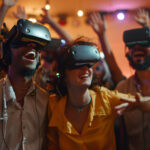
We Have the Most Popular VR Party Games of 2025.
June 30, 2024
Taking Your Trade Show to the Next (Virtual) Level with VR
July 27, 2024Art and VR
Using VR headsets for an art exhibition introduces a transformative dimension to the traditional gallery experience, merging cutting-edge technology with artistic expression. This innovative approach not only enhances viewer engagement but also expands the possibilities of how art can be experienced and interpreted.
Enhanced Immersion and Interaction
VR headsets offer a level of immersion that traditional art exhibitions cannot match. They transport viewers into virtual worlds where artworks can be explored in a dynamic and interactive manner. For example, a painting can be viewed from different angles, allowing viewers to appreciate intricate details that may not be visible in a static display. Sculptures can be examined closely, providing a sense of scale and texture that goes beyond what is possible in a physical gallery.
Accessibility and Inclusivity
One of the significant advantages of using VR headsets in art exhibitions is enhanced accessibility. Virtual reality can break down physical barriers by allowing people from different locations to experience the exhibition simultaneously. This inclusivity expands the audience reach beyond the confines of a physical space, making art more accessible to individuals who may not have the means or ability to attend in person.
Experimental and Conceptual Art
VR technology encourages artists to explore experimental and conceptual art forms that challenge traditional boundaries. Artists can create immersive environments that respond to viewer interactions, blurring the lines between the virtual and physical worlds. This opens up new possibilities for artistic expression, enabling artists to push the limits of creativity and engage audiences in novel ways.
Educational Opportunities
VR headsets provide valuable educational opportunities within art exhibitions. They can be used to contextualize artworks by providing historical background, artist biographies, or explanations of artistic techniques. Educational institutions and museums can leverage VR technology to create interactive learning experiences that deepen understanding and appreciation of art among students and visitors.
Cost-Effective Exhibition Solutions
For art institutions and galleries, VR headsets offer cost-effective exhibition solutions. They eliminate the need for transporting valuable artworks across long distances, reducing logistical challenges and risks associated with handling fragile pieces. Virtual exhibitions can be easily updated or modified without the constraints of physical space, allowing curators to experiment with different layouts and themes.
Global Reach and Cultural Exchange
Virtual reality facilitates global reach and cultural exchange in the art world. Artists from diverse backgrounds can showcase their work to international audiences without geographical limitations. Viewers can explore artworks influenced by different cultures and traditions, fostering cross-cultural dialogue and appreciation.
Community Engagement and Outreach
VR exhibitions can enhance community engagement and outreach initiatives. They provide opportunities for local artists to showcase their work to a broader audience and encourage community participation through virtual workshops, artist talks, or interactive installations. Virtual reality fosters a sense of connection and collaboration within artistic communities, promoting creativity and cultural exchange.
Challenges and Considerations
While VR headsets offer numerous benefits for art exhibitions, there are challenges and considerations to address. Technical requirements, such as high-quality hardware and software, must be met to ensure a seamless and immersive experience for viewers. And that’s were we at Sherpa VR come in! We can help the experience go smoothly for your artist vision. We can accommodate small to medium size exhibitions. Please contact us for more information on how to get started.
In conclusion, using VR headsets for an art exhibition revolutionizes how art is experienced, interpreted, and appreciated. It expands accessibility, enhances viewer engagement, and encourages artistic experimentation. By leveraging virtual reality technology, art institutions, galleries, and artists can create dynamic and inclusive exhibition experiences that transcend physical boundaries and inspire creativity across global audiences.
